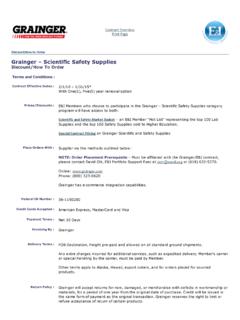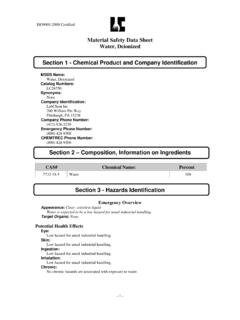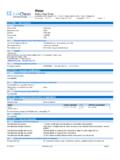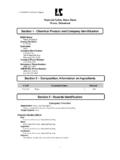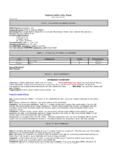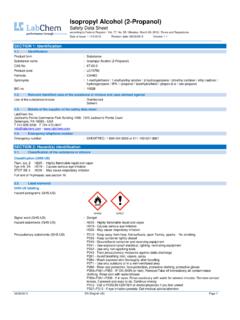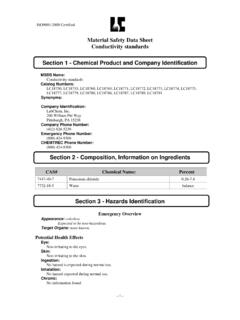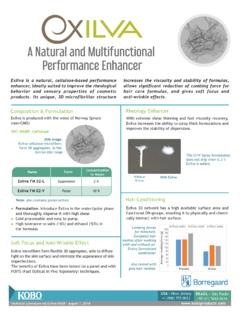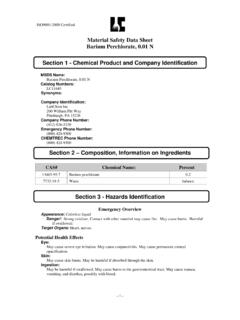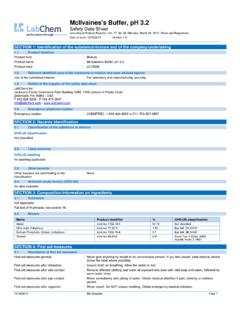Transcription of Material Safety Data Sheet - Our Research
1 Material Safety Data Sheet Sodium acetate solutions ACC# 75270 MSDS Name: Sodium acetate solutions Catalog Numbers: LC22830, LC22840, LC22850 Synonyms: Company Identification: labchem Inc. 200 William Pitt Way Pittsburgh, PA 15238 For information, call: 412-826-5230 For CHEMTREC assistance, call: 800-424-9300 For International CHEMTREC assistance, call: 703-527-3887 Hazard Symbols: None listed. Risk Phrases: None listed. EMERGENCY OVERVIEW Appearance: colorless. May cause digestive tract irritation. May cause eye and skin irritation. Target Organs: None known.
2 Potential Health Effects Eye: May cause eye irritation. Skin: May cause skin irritation. Ingestion: Ingestion may cause abdominal pain, vomiting. Inhalation: May cause respiratory tract irritation. Chronic: Not available. Eyes: Flush eyes with plenty of water for at least 15 minutes, occasionally lifting the upper and lower lids until no evidence of chemical remains. Get medical aid at once. Skin: Get medical aid. Immediately flush skin with plenty of soap and water for at least 15 minutes Section 1 - Chemical Product and Company Identification Section 2 - Composition, Information on Ingredients CAS#Chemical NamePercentEINECS/ELINCS6131-90-4 Sodium acetate, trihydrate20-27 unlisted 7732-18-5 Waterbalance 231-791-2 Section 3 - Hazards Identification Section 4 - First Aid Measures Page 1 of 512/29/2009 removing contaminated clothing and shoes.
3 Remove contaminated clothing and shoes. Ingestion: Treat symptomatically and supportively. Get medical aid at once. If vomiting occurs, keep head lower than hips to prevent aspiration. Inhalation: Give artificial respiration if necessary. Get medical aid. Keep victim warm, at rest. Move victim to fresh air. Notes to Physician: Treat symptomatically. General Information: Negligible fire and explosion hazard when exposed to heat or flame. Move container if possible, avoid breathing vapors or dust. Extinguishing Media: For small fires, use dry chemical, carbon dioxide, water spray or alcohol-resistant foam. General Information: Use proper personal protective equipment as indicated in Section 8.
4 Spills/Leaks: Absorb spills with absorbent (vermiculite, sand, fuller's earth) and place in plastic bags for later disposal. Handling: Wash thoroughly after handling. Avoid breathing dust, vapor, mist, or gas. Storage: Store capped at room temperature. Protect from heat and incompatibles. Engineering Controls: Provide local exhaust or general dilution ventilation. Exposure Limits OSHA Vacated PELs: Sodium acetate, trihydrate: No OSHA Vacated PELs are listed for this chemical. Water: No OSHA Vacated PELs are listed for this chemical. Personal Protective Equipment Eyes: Do not wear contact lenses when working with chemicals.
5 An eye wash fountain should be available in the immediate work area. Wear splash-proof Safety goggles. Skin: Wear appropriate protective gloves to prevent skin exposure. Clothing: Wear appropriate protective clothing to prevent skin exposure. Respirators: Not required for normal use. Firefighting-- any self-contained breathing apparatus with full facepiece operated in pressure-demand mode. Section 5 - Firefighting Measures Section 6 - Accidental Release Measures Section 7 - Handling and Storage Section 8 - Exposure Controls, Personal Protection Chemical NameACGIHNIOSHOSHA - Final PELsSodium acetate, trihydratenone listednone listednone listedWaternone listednone listednone listedPage 2 of 512/29/2009 Physical State: Clear liquid Appearance: colorless Odor: odorless pH: slightly alkaline Vapor Pressure: Not available.
6 Vapor Density: Not available. Evaporation Rate:Not available. Viscosity: Not available. Boiling Point: Not available. Freezing/Melting Point:Not available. Decomposition Temperature:Not available. Autoignition Temperature: Not available. Flash Point: Not available. NFPA Rating: Not published. Explosion Limits, Lower:Not available. Upper: Not available. Solubility: Soluble. Specific Gravity/Density:Not available. Molecular Formula:Not available. Molecular Weight:Not available. Chemical Stability: Stable under normal temperatures and pressures. Conditions to Avoid: Incompatible materials. Incompatibilities with Other Materials: Oxidizing agents.
7 Hazardous Decomposition Products: Oxides of carbon, sodium oxide. Hazardous Polymerization: Has not been reported RTECS#: CAS# 6131-90-4 unlisted. CAS# 7732-18-5 unlisted. LD50/LC50: Not available. CAS# 7732-18-5: Oral, rat: LD50 = >90 mL/kg; Carcinogenicity: CAS# 6131-90-4: Not listed by ACGIH, IARC, NIOSH, NTP, or OSHA. CAS# 7732-18-5: Not listed by ACGIH, IARC, NIOSH, NTP, or OSHA. Epidemiology: No data available. Teratogenicity: No data available. Reproductive Effects: No data available. Neurotoxicity: No data available. Section 9 - Physical and Chemical Properties Section 10 - Stability and Reactivity Section 11 - Toxicological Information Page 3 of 512/29/2009 : No data available.
8 Other Studies: No data available. No information available. Chemical waste generators must determine whether a discarded chemical is classified as a hazardous waste. US EPA guidelines for the classification determination are listed in 40 CFR Parts Additionally, waste generators must consult state and local hazardous waste regulations to ensure complete and accurate classification. RCRA P-Series: None listed. RCRA U-Series: None listed. US FEDERAL TSCA CAS# 6131-90-4 is not on the TSCA Inventory. It is a hydrate and exempt from TSCA Inventory requirements ( (u)(2)). CAS# 7732-18-5 is listed on the TSCA inventory.
9 Health & Safety Reporting List None of the chemicals are on the Health & Safety Reporting List. Chemical Test Rules None of the chemicals in this product are under a Chemical Test Rule. Section 12b None of the chemicals are listed under TSCA Section 12b. TSCA Significant New Use Rule None of the chemicals in this Material have a SNUR under TSCA. SARA Section 302 (RQ) None of the chemicals in this Material have an RQ. Section 302 (TPQ) Section 12 - Ecological Information Section 13 - Disposal Considerations Section 14 - Transport Information US DOTIATARID/ADRIMOC anada TDGS hipping Name:No information information Class:UN Number:Packing Group:Section 15 - Regulatory Information Page 4 of 512/29/2009 of the chemicals in this product have a TPQ.
10 SARA Codes CAS # 6131-90-4: acute. Section 313 No chemicals are reportable under Section 313. Clean Air Act: This Material does not contain any hazardous air pollutants. This Material does not contain any Class 1 Ozone depletors. This Material does not contain any Class 2 Ozone depletors. Clean Water Act: None of the chemicals in this product are listed as Hazardous Substances under the CWA. None of the chemicals in this product are listed as Priority Pollutants under the CWA. None of the chemicals in this product are listed as Toxic Pollutants under the CWA. OSHA: None of the chemicals in this product are considered highly hazardous by OSHA.


